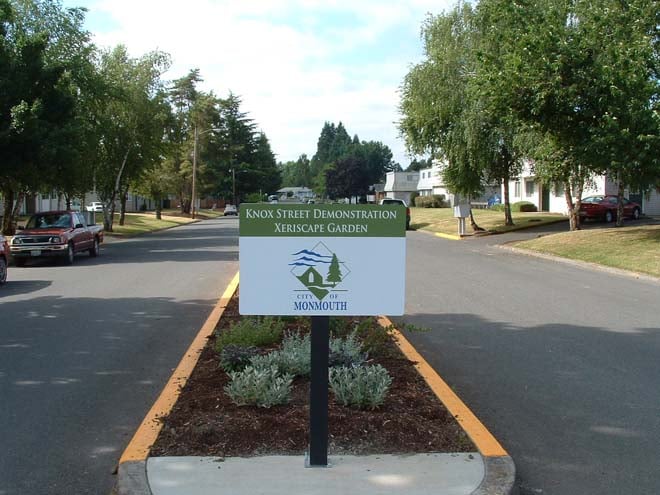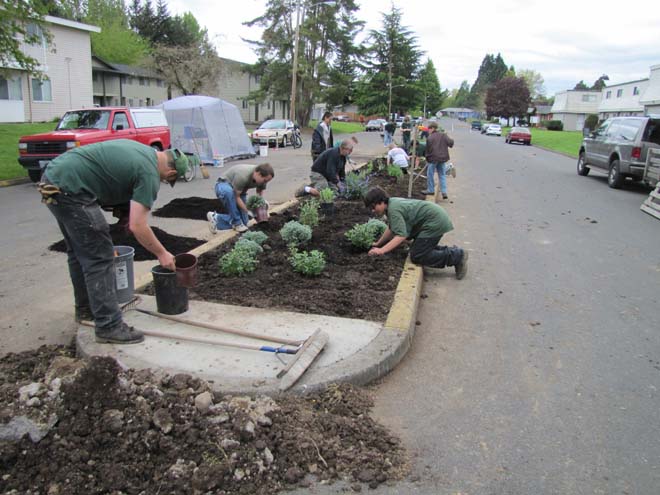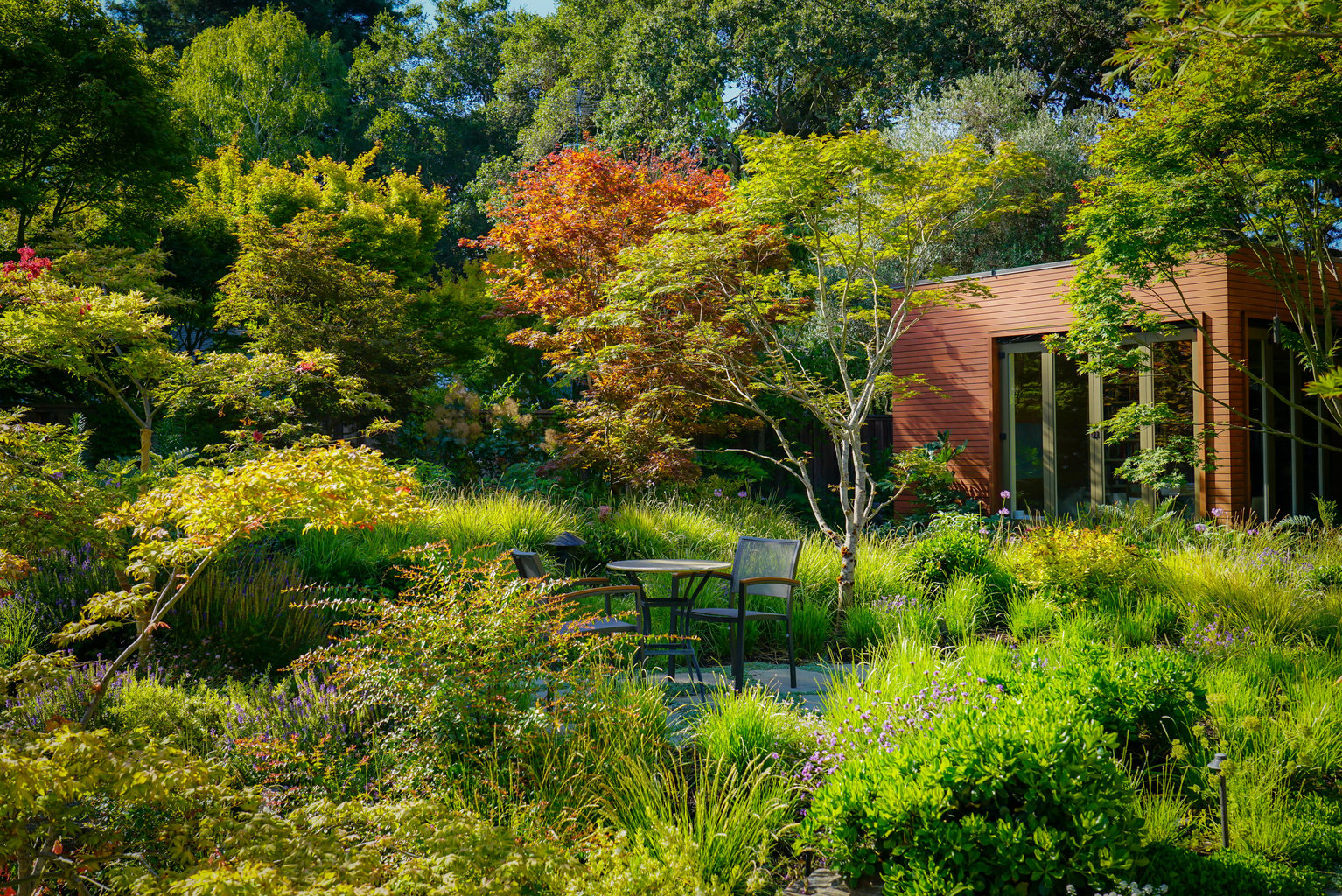

Contributor
- Topics: Archive

All gardeners learn by viewing landscapes. Avid gardeners read gardening magazines like Pacific Horticulture, join a gardening society or club, and visit botanical gardens. These committed hobbyists and professionals likely spend considerably more time—and money!—pursuing inspiration while more casual gardeners consult family, friends and neighbors, garden center staff, extension agents, Master Gardeners, and mass media for answers to their gardening questions.
My experience as a horticulturist and occasional consultant on such projects has led me to the idea that public landscapes can provide gardening inspiration, landscaping solutions, and beauty. When the city of Dallas, Oregon, planted crape myrtle (Lagerstroemia sp.) street trees, the vivid blooms in late summer prompted calls to city hall to find out what they were—presumably because callers wanted to get one. This suggests the value of putting examples of desirable landscaping out there where people can see them.
For better or worse, our communities are filled with planting examples: small areas like traffic islands, curbside “hell strips,” and parking lots. In some cases, these spaces are maintained by dedicated individuals, volunteer groups, or knowledgeable public works staff and the resulting landscapes contribute aesthetically to the community. In other instances, no ownership is apparent and these spaces persist in a forlorn state year in and year out, often lucky to receive a haircut with a weed trimmer or an herbicide application, if anything at all.
Monmouth, Oregon, is dotted with the same anonymous, semi-maintained spaces you can find anywhere. Like most cities, budget limitations challenge staff to maintain—nevermind improve—community landscapes. One such space was a series of three traffic islands bisecting Knox Street in a residential area near Western Oregon University. The three islands are between 90 and 135 feet long and 6 feet wide. Ignored for years, most of the plant life in the traffic islands consisted of annual bluegrass.
Committed to improving a dismal situation, Community Development Director Mark Fancey envisioned a community-based project that would not only answer the landscape needs of the site, but would serve as an ongoing learning opportunity. Fancey enlisted the help of James Sorrels, a senior at Central High School in Monmouth. Like other students in the district, James was required to complete a community service project in order to graduate, and had approached the city about ideas to meet this requirement. After discussing the project with Mark, James was put in charge of overseeing the effort to transform the Knox Street site.

Like other plantings of this kind, the Knox Street project offered a few challenges. The lack of any meaningful groundcover meant that the soil had suffered considerable compaction from rainfall and foot traffic—along with the occasional car tire. No irrigation was available and, since it is surrounded by asphalt and in full sun, any landscape would be subject to considerable heat and drought stress in the summer.
The site naturally lent itself to installing a drought-tolerant landscape with plants that would grow and flower without any supplemental irrigation. Good examples of this type of landscape are not as common as you might think in the Pacific Northwest. More often, genuinely drought-tolerant plants, such as Cistus or Ceanothus are combined with other plants that are not at all drought-tolerant, or irrigation is installed and planted areas receive irrigation in the summer, although perhaps at a reduced rate.

Beyond drought tolerance, the Knox Street landscape was designed to provide year-round textural and floral interest and be low maintenance with minimal pruning and weed control requirements. Because of these priorities, the location, and constricted space of the traffic islands, most of the chosen plants are evergreen and many have a relatively low-growing, spreading growth habit like purple garden sage (Salvia officinalis ‘Purpurascens’), Dorycnium hirsutum, Erysimum ‘Julian Orchard’, and Brachyglottis greyi (syn. Senecio greyi)—plants familiar to most gardeners. Other less commonly used plants like Ceanothus ‘Tilden Park’, Cistus ×obtusifolius, Grevillea juniperina ‘Molonglo’, and Halimium lasianthum ‘Sandling’ are effective and unusual contributors to the groundcover palette.
To provide vertical interest without interrupting sight lines, upright-growing, but see-through plants such as Russian sage (Perovskia atriplicifolia) and giant feather grass (Stipa gigantea) were included at intervals, as well as more rare plants like fuchsia- flowering gooseberry (Ribes speciosum). Floral interest would be sustained by the Erysimum from early spring through summer, and well into fall by the bright red blooms of California fuchsia (Epilobium canum). It won’t hurt the appeal of the planting that most of the plants have blooms that attract pollinators as well as butterflies and hummingbirds.
James worked with wholesale sources for the most part to find the plants, and enlisted the support of his Eagle Scout troop to assist with site preparation and planting. The grade was slightly low in each island but, fortunately, a parking lot project less than a block from the traffic islands provided a supply of excellent topsoil. The planting beds were topped up, leveled, graded, and ready for planting. On May 5, 2012, a group of about 30 volunteers descended on the site and within three hours had the entire site planted, watered, and mulched. Late-season planting required that the landscape be hand-watered for the remainder of the summer, a task Mark undertook himself.

The finished project improves the appearance of the street and has served an educational role as well. On-site signage depicts the landscape’s design along with the names of the plants that were used. The concept behind the planting is outlined including basics about the local climate and the requirements and special characteristics of a “low-input” landscape, chiefly winter cold hardiness and summer drought tolerance. The Knox Street planting provides a successful template for small-space gardeners looking to create a landscape with year-round interest without an excess of expense or work.
Share:
Social Media
Garden Futurist Podcast
Most Popular
Videos
Topics
Related Posts

Low Maintenance Gardens – Better for Pollinators and People
Autumn 2022 “I come out every day. It’s therapy, my meditation.” Janet’s young garden transformed from overgrown, invasive plants to mostly natives. The dailiness of

Invasive Plants Are Still Being Sold: Preventing Noxious Weeds in Your Landscape
Autumn 2022 With so many beautiful ornamental plant species and cultivars throughout California and the Pacific Northwest, how do you decide which ones to include

Garden Design in Steppe with Transforming Landscapes with Garden Futurist Emmanuel Didier
Summer 2022 Listen to full Garden Futurist: Episode XVII podcast here. Emmanuel Didier, Principal and Creative Director at Didier Design Studio is a leading figure

Seslerias: Versatile Groundcover Meadow Grasses
Summer 2022 Without question, the most beautiful and versatile of all the groundcover meadow grasses are the moor grasses (Sesleria). Moor grasses tick off all








Responses